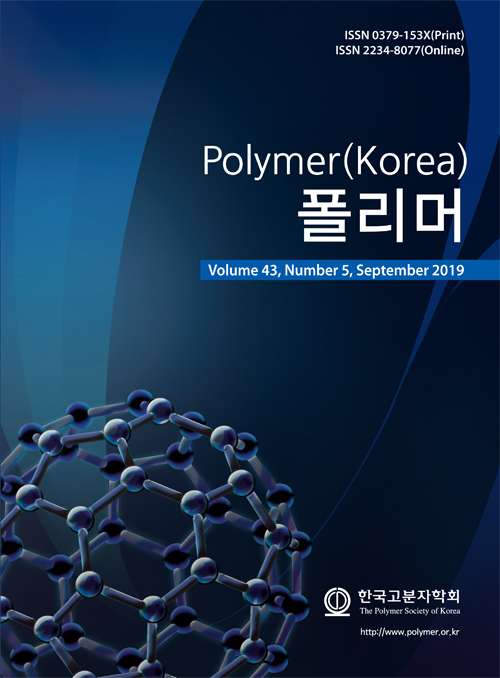- Nanoscale Wrinkles on a Partially Cured Surface Using Polyurethane Acrylate Resins
Department of Chemical Engineering, Hoseo University, Asan 31499, Korea
*MCNet Company Ltd., Gwangju 12774, Korea
- 폴리우레탄 아크릴레이트 수지를 이용한 부분 경화 표면에서의 나노크기 주름
호서대학교 화학공학과, *㈜엠씨넷
In
this study, curing properties including molecular structures, gel fraction and
wrinkles by content of each composition in polyurethane acrylate (PUA)
resins composed of precursors and modulators with many functional groups, were
investigated. The sample structure was analyzed by carbon-to-carbon double bond
with the Fourier transform-infrared spectroscopy. The gel fraction was
calculated using the measurement of weights by ultraviolet curing time and
weight comparison before and after curing. Compressive stress was applied to
the lower PUA by adjusting the shrinkage of the upper PUA which locally exists
in pillar form, and wrinkles were formed on the surface of the single lower PUA
between pillars through it. Then, the surface morphology was examined by
using atomic force microscopy. As a result, as the shrinkage rate of the upper PUA increased, the single lower
PUA was further stretched and the wavelength of wrinkles decreased.
본 연구에서는
전구체와 여러 관능기를 가진 모듈레이터로 이루어진 polyurethane acrylate(PUA)
수지의 각 구성
성분 함량에 따른 구조와 젤분율 및 주름과 같은 경화 특성을 연구하였다. 시료 구조는 푸리에 변환-적외선 분광법을 이용해 탄소간 이중 결합에 따라 분석을 진행하였다. 자외선
경화 시간에 따른 무게 측정 및 경화 전후 무게 비교를 통해
젤분율을 계산하였다. 기둥 형태로 국부적으로 존재하는 상부 PUA의
수축률을 조절하여 하부 PUA에 압축응력을 가하고, 이를
통해 기둥 사이의 근접한 단일 하부 PUA의 표면에 주름을 형성한 후 원자힘 현미경을 통해 특성을 파악하였다. 결과적으로, 상부 PUA의
수축률이 증가함에 따라 단일 하부 PUA가 더욱 연신되면서 생성되는 주름의 파장이 감소하였다
Keywords: selective wrinkling, shrinkage, nanopatterning
- Polymer(Korea) 폴리머
- Frequency : Bimonthly(odd)
ISSN 0379-153X(Print)
ISSN 2234-8077(Online)
Abbr. Polym. Korea - 2023 Impact Factor : 0.4
- Indexed in SCIE
 This Article
This Article
-
2019; 43(6): 926-932
Published online Nov 25, 2019
- 10.7317/pk.2019.43.6.926
- Received on Aug 8, 2019
- Revised on Aug 26, 2019
- Accepted on Aug 28, 2019
 Correspondence to
Correspondence to
- Dongchul Suh
-
Department of Chemical Engineering, Hoseo University, Asan 31499, Korea
- E-mail: dongchul.suh@gmail.com









 Copyright(c) The Polymer Society of Korea. All right reserved.
Copyright(c) The Polymer Society of Korea. All right reserved.